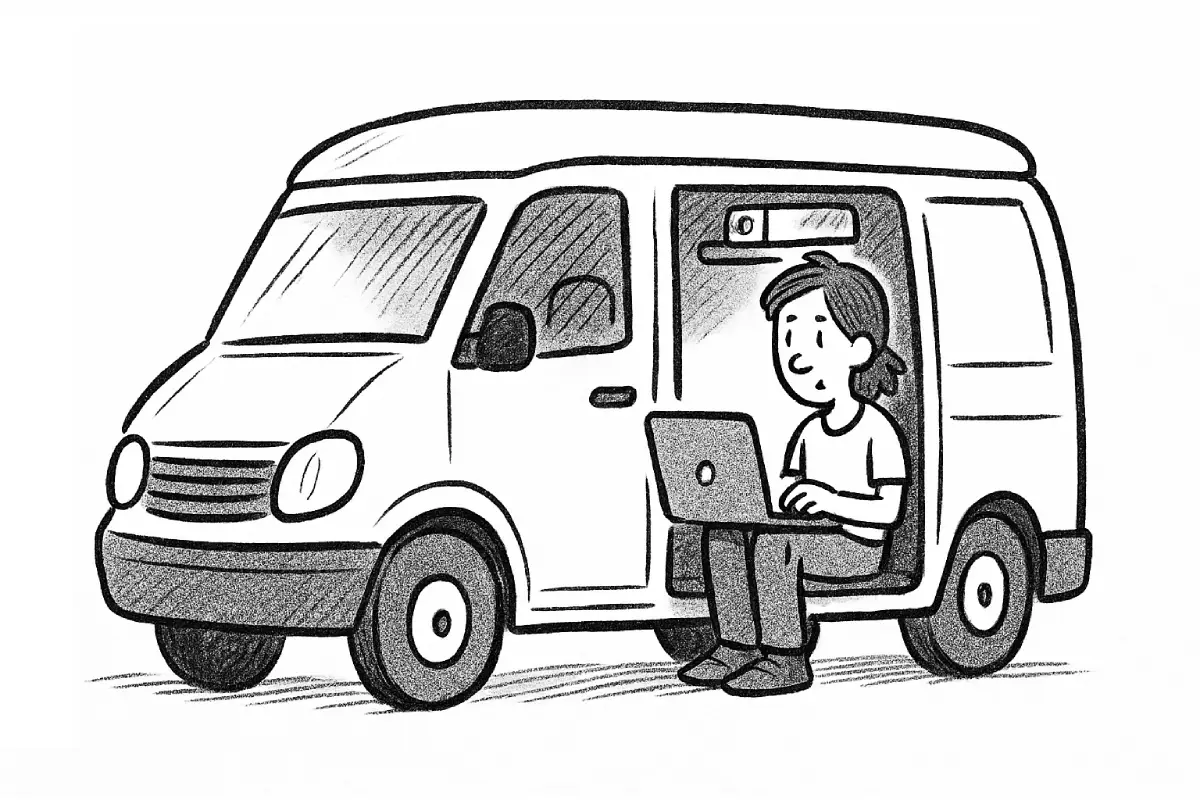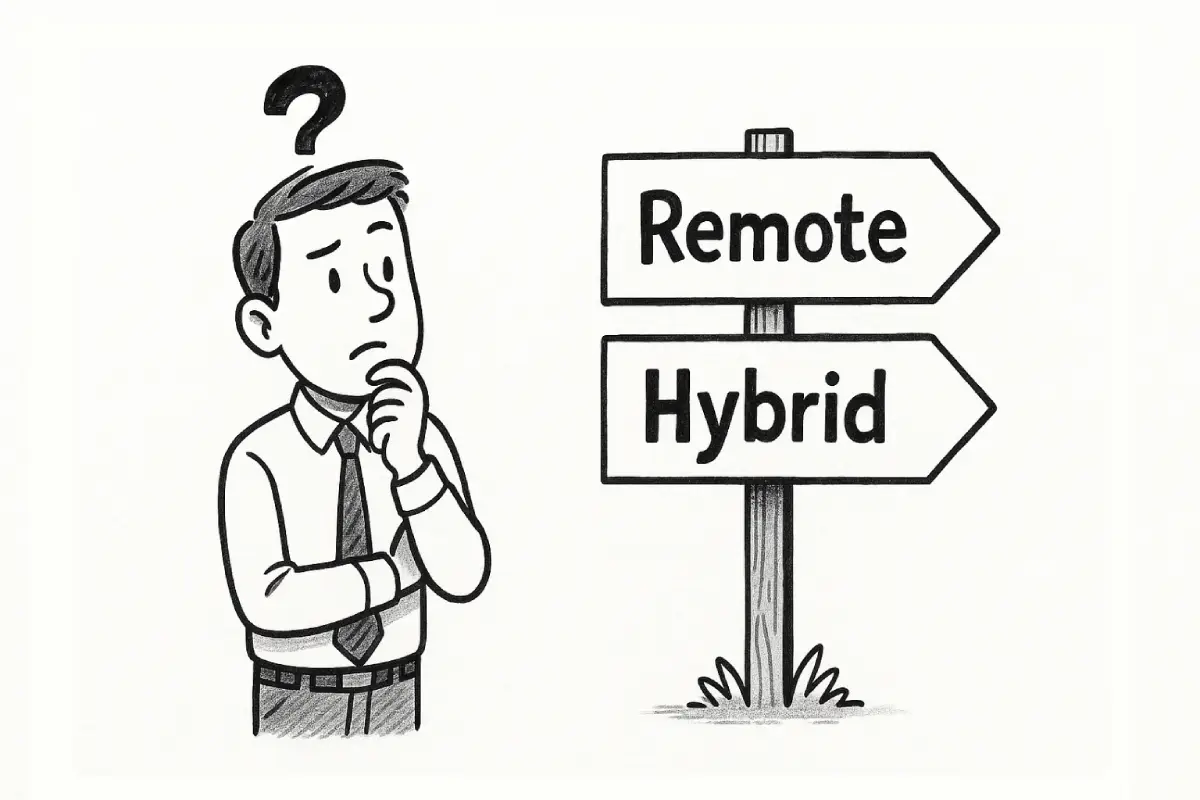Scroll through the #vanlife tag on Instagram, and you’ll be sold a beautiful lie.
It’s a fantasy served in perfectly filtered, sun-drenched squares: a handsome couple with flawless hair, sipping artisanal coffee as they gaze out the back of a pristine Sprinter van at a breathtaking mountain vista. Their laptop is open, but they’re not really working. They’re being. They are living the dream—a dream of ultimate freedom, where work is a casual afterthought, a brief interruption to an endless adventure.
But for those of us who have actually tried to take a Zoom call from a Walmart parking lot while desperately trying to poach Wi-Fi, the reality looks a little different.
The truth about working from a van is less about scenic backdrops and more about a frantic, daily calculus of three precious resources: power, internet, and a quiet place to park where you won’t get that dreaded knock on the window at 2 a.m.
The dream is real, but it’s not effortless. It’s a trade-off. You trade the stability of a fixed address for the freedom of the open road, but you also trade the convenience of reliable utilities for a life of constant problem-solving. Making a living in this environment isn’t just about having a remote job; it’s about having the right kind of remote job—one that can withstand the beautiful chaos of life on the move.
The Holy Trinity: The Non-Negotiable Needs of a Road Warrior
Before we even talk about what jobs work, we have to be brutally honest about the constraints. Your ability to earn a living from a 70-square-foot metal box hinges entirely on these three things.
1. The Internet Quest: Reliable internet is the lifeblood of any remote worker, but for a vanlifer, it’s an obsession. It’s a constant, multi-pronged battle. You have your cellular hotspot, which works great until you find that perfect, secluded campsite that is, of course, a total dead zone. You have Starlink, which has been a game-changer for many, but it’s expensive, power-hungry, and needs a clear view of the sky—a problem in dense forests or deep canyons. Then there’s the age-old strategy of loitering at libraries and coffee shops, which works until you have a confidential client call and can’t discuss sensitive information over the hiss of a cappuccino machine. A successful vanlife worker isn’t just a professional; they are a part-time network engineer.
2. The Power Game: Your entire professional life runs on electricity. Your laptop, your phone, your hotspot, your lights—they all need juice. This means you’re not just a worker; you’re the manager of a tiny, mobile power plant. You’re obsessively checking your solar panel input on cloudy days, monitoring your battery levels like a hawk, and making decisions like, “Can I charge my laptop and run the fridge at the same time, or will that plunge my entire existence into darkness?” Forgetting to charge your power bank isn’t an inconvenience; it’s a potential catastrophe that could cost you a client.
3. The Space (or Lack Thereof): A van is a marvel of compressed living, but it’s still a tiny space. Finding a quiet, professional-looking background for a video call can be a hilarious challenge. Your “office” is also your kitchen, your bedroom, and your garage. The idea of a dedicated, ergonomic workspace is a luxury most vanlifers sacrifice. Your posture might suffer, and your ability to focus with your entire life packed into your peripheral vision is a skill that takes time to develop.

The Jobs That Actually Work: A Field Guide
Given these constraints, not all remote jobs are created equal. The best jobs for vanlife fall into a few distinct categories, each with its own set of pros and cons.
The Asynchronous Professional
This is the gold standard. These are roles where the majority of your work can be done on your own schedule, without the need for constant, real-time collaboration. You’re judged on your output, not on whether your Slack icon is green at 2:37 p.m.
- The Work: This includes many roles like software development, copywriting, graphic design, video editing, and technical writing. The key is that the work is project-based. You get an assignment, you have a deadline, and how you get it done between Point A and Point B is largely up to you.
- Why it Works: This model is resilient to the unpredictability of the road. Have no internet for a day because you’re driving through the mountains? No problem. You can work offline and upload everything when you get back to civilization. Need to spend the sunniest part of the day hiking and work at night? Go for it. This flexibility is what the vanlife dream is truly about. The growth of the freelance economy, which is full of these types of roles, has made this path more viable than ever. A recent report from Upwork, for example, highlights that a significant portion of the workforce is now participating in freelancing, showcasing the scale of this opportunity.
The Real-Time Operator
These jobs are trickier but still very possible. They require you to be online and available during set hours for meetings, calls, and instant communication.
- The Work: Think customer service representatives, project managers, virtual assistants, online tutors, and anyone in a client-facing sales or account management role.
- Why it Works (and Doesn’t): This requires a much higher level of planning and a more robust tech setup. You can’t risk your internet dropping in the middle of a client presentation. People in these roles often spend more time in urban areas or established campgrounds with reliable amenities. They might chase cell towers more than they chase sunsets. The trade-off is often a more stable, predictable income, but it comes at the cost of some of the freewheeling spontaneity.
The Gig Economy Patchwork
This is the original vanlife hustle, and it’s still a popular route. This isn’t about a single remote job, but about stitching together an income from various seasonal, temporary, or location-based gigs.
- The Work: This could be working the beet harvest in North Dakota, being a camp host in a national park, working at an Amazon CamperForce warehouse during the holiday season, or picking up bartending or restaurant shifts in a tourist town for a few months before moving on.
- Why it Works: It fully embraces the nomadic lifestyle. Your work is tied to the places you want to be. It’s incredibly social and allows you to immerse yourself in local communities. The downside is a lack of income stability and the need to constantly be looking for the next gig. It’s a hustle in the truest sense of the word.
The reality is, most successful long-term vanlifers are a hybrid of all three. They might have a primary asynchronous freelance client that pays most of the bills, supplemented by a few hours of real-time virtual assistant work and a plan to work at a ski resort for a month in the winter.
Living and working from a van is not an escape from responsibility; it’s an exchange of one set of responsibilities for another. You trade office politics for weather forecasts, and performance reviews for battery voltage checks. It requires a level of resourcefulness, planning, and grit that the Instagram photos never show. But for those who can master the chaos, the reward is the one thing a traditional job can never offer: a different sunset out your office window every single night.
You might also like: How to Cope With Layoffs Without Losing Confidence









